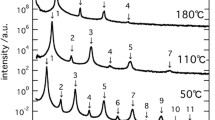Abstract
The phase diagram for a low molecular weight blend of deuterated polystyrene (PSD) and polybutadiene (PB) was determined by temperature jump light scattering (TJLS) measurements and phase contrast optical microscopy (PCOM). The PSD/PB blend exhibited upper critical solution temperature behavior, and the critical temperatures measured by these two techniques were consistent. Upon addition of 0 to 0.12 mass fraction of a comparable molecular weight PSD-PB symmetric diblock copolymer, a linear decrease in the phase transition temperature was observed with increasing diblock copolymer content. At a constant, shallow quench depth, the kinetics of phase separation via spinodal decomposition as measured by TJLS were greatly retarded by the presence of the copolymer. Additionally, the time dependence of the concentration fluctuation growth did not seem to follow a universal functional form anywhere in the accessible q range when the diblock was present. The results of morphology study of the blends in the late stage of phase separation by PCOM also indicated that the phase separated domain sizes did not grow to the same size for a given annealing time as diblock content increased.
Similar content being viewed by others
References and Notes
D. R. Paul,Polymer Blends, D. R. Paul, S. Newman, Eds.; Academic Press: New York, 1978; Vol. 2, Chapter 12.
D. J. Walsh, J. S. Higgins and A. Maconnachie,Polymer Blends and Mixtures, NATO Advanced Study Institute on Polymer Blends and Mixtures, Martinus Nijhoff, Dordrecht, 1985.
L. A. Utracki,Polymer Alloys and Blends: Thermodynamics and Rheology, Hanser, NY, 1989.
B. M. Culberston,Contemporary Topics in Polymer Science, Vol. 6, Multiphase Macromolecules Systems, Plenum, NY, 1989.
R.-J. Roe and D. Rigby,Adv. Polym. Sci.,82, 103 (1987).
P. Marie, J. Selb, A. Rameau, R. Duplessix, Y. Gallot, in Ref. 2; J. Selb, P. Marie, A. Rameau, R. Duplessix and Y. Gallot,Polym. Bull. (Berlin),10, 444 (1983).
D. Rigby, J. L. Lin and R.-J. Roe,Macromolecules,18, 2269 (1985).
R.-J. Roe and C. M. Kuo,Macromolecules,23, 4635 (1990).
D. W. Park and R.-J. Roe,Macromolecules,24, 5324 (1991).
S. Y. Hobbs, M. E. J. Dekkers and V. H. Watkins,Polymer,29, 1599 (1988).
S. Thomas and R. E. Prud'homme,Polymer,33, 4259 (1992).
U. Sundararaj and C. W. Macosko,Macromolecules,28, 2647 (1995).
L. N. Andradi and G. P. Hellman,Polym. Eng. Sci.,35(8), 693 (1995).
A. Adedeji, A. M. Jamieson and S. D. Hudson,Macromolecules,27, 4018 (1994).
T. Inoue, T. Shoen, T. Hashimoto and H. Kawai,Macromolecules,3, 87 (1970).
B. Löwenhaupt and G. P. Hellmann,Colloid and Polymer Sci.,272, 121 (1994).
B. Löwenhaupt and G. P. Hellmann,Colloid and Polymer Sci.,268, 885 (1990).
J. Tao, M. Okada, T. Nose and T. Chiba,Polymer,36, 3909 (1995).
M. Okamoto, K. Shiomi and T. Inoue,Polymer,36, 87 (1995).
H. Hashimoto, M. Fujimura, T. Hashimoto and H. Kawai,Macromolecules,14, 844 (1981).
R. Fayt, R. Jerome and Ph. Teyssie,J. Polym. Lett. Ed.,24, 25 (1986).
L. Leibler,Macromolecules,15, 1283 (1982).
J. Noolandi and K. M. Hong,Macromolecules,15, 482 (1982);Macromolecules,17, 1531 (1984).
M. D. Whitmore and J. Noolandi,Macromolecules,18, 657 (1985).
S. H. Anastasiadis, I. Gancarz and J. T. Koberstein,Macromolecules,21, 2980, (1988);Macromolecules,22, 1449 (1989).
According to ISO 31-8, the term “Molecular Weight” has been replaced by “Relative Molecular Mass”, symbol Mr. Thus, if this nomenclature and notation were to be followed in this publication, one would write Mr.n instead of the historically conventional Mn for the number average molecular weight, with similar changes for Mw, Mz and Mv, and it would be called the “Number Average Relative Molecular Mass”. The conventional notation, rather than ISO notation, has been employed for this publication.
P. Gaillard, M. Ossenbach-Sauter and G. Riess,Makromol. Chem. Rapid Commun.,1, 771 (1980).
T. Hashimoto, T. Izumitani,Macromolecules,26, 3631 (1993); T. Izumitani and T. Hashimoto,Macromolecules,27, 1744 (1994).
C. C. Lin, H. S. Jeon, N. P. Balsara and B. Hammouda,J. Chem. Phys.,103, 1957 (1995).
L. Sung and C. C. Han,J. Polym. Sci.,33, 2405 (1995).
T. Kawakatsu, K. Kawasaki, Phys. A167, 690 (1990); T. Kawakatsu, K. Kawasaki, M. Furusaka, H. Okabayashi and T. Kaneya,J. Chem. Phys.,99, 8200 (1993).
L. Sung and C. C. Han,to be published.
All commercial equipment, instruments, or materials are identified in this article in order to adequately specify the experimental procedure, such identification does not imply recommendation or endorsement by the National Institute of Standards and Technology; nor does it imply that materials or equipment identified are necessarily the best available for the purpose.
M. He, Y. Liu, Y. Feng, M. Jiang and C. C. Han,Macromolecules,24, 464 (1991).
T. Sato and C. C. Han,J. Chem. Phys.,88, 2057 (1988).
B. Endres, R. W. Garbella, J. H. Wendorff,Coll. Polym. Sci.,263, 361 (1985).
R. M. Briber and F. Khoury,Polymer,28, 38 (1987).
“Polymer Handbook”, 3rd Ed., J. Brandrup and E. H. Immergut. Eds., Wiley-Interscience. 1989.
All ± values cited within are estimated uncertainties based on multiple prior measurements with equipment utilized.
D. W. Hair, E. K. Hobbie, J. F. Douglas and C. C. Han,Phys. Rev. Lett.,68, 2476 (1992).
J. W. Cahn and J. E. Hillard,J. Chem. Phys.,31, 688 (1959); J. W. Cahn,ibid.,42, 93 (1965).
H. E. Cook,Acta Metall.,18, 297 (1970).
H. Jinnai, H. Hasegawa and T. Hashimoto,J. Chem. Phys.,99, 4845 (1993).
Detailed discussions of the exponents α and β can be found in Chapter 2 in Ref. 3 and T. Hashimoto, M. Itakura and N. Shimidzu,J. Chem. Phys.,85, 6773 (1985); H. L. Snyder, P. Meakin,J. Polym. Sci.: Polym. Symposium,73, 217 (1985).
H. L. Snyder, P. Meakin,J. Chem. Phys.,79, 5588 (1983);J. Chem. Phys.,78, 3334, (1984); H. L. Snyder, P. Meakin and S. Reich andMacromolecules,16, 775 (1983).
C. L. Jackson, L.Sung and C. C. Han,submitted to Polym. Eng. Sci. (1996).
J. Dudowicz, K. F. Freed and J. F. Douglas,Macromolecules,28, 2276 (1995).
I. M Lifzhitz, V. V. Slyozov,J. Phys. Chem. Solids,19, 35 (1961); A. Z. Akcasu and R. Klein,Macromolecules,26, 1429 (1993); A. J. Bray,Adv. Phys.,43, 357 (1994).
Author information
Authors and Affiliations
Rights and permissions
About this article
Cite this article
Sung, L., Hess, D.B., Jackson, C.L. et al. Phase separation kinetics and morphology in a polymer blend with diblock copolymer additive. J Polym Res 3, 139–150 (1996). https://doi.org/10.1007/BF01494523
Issue Date:
DOI: https://doi.org/10.1007/BF01494523




